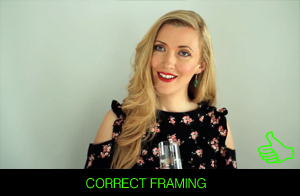Make sure you can be seen and heard clearly.
Ensure that background noise is kept to a minimum and that the camera is at your eye-level. Your light source should be in front of you and not in the shot – don’t sit with a window behind you as it can put you in shadow.

Unless otherwise requested a medium shot where you can see your head and shoulders is best. If recording on a computer, set the angle so that you are not looking down at the camera. If using a phone try and use a tripod, and hold the phone in a landscape position (on its side).
Lighting
Try to record in natural light and stay away from shadowy areas in your house.
Backdrop
Film your audition against a plain background, preferably in front of a pale coloured wall. If possible avoid having anything distracting (clocks, posters, flowery wallpaper) on the wall behind you.
Hanging a grey or blue bed sheet behind you is better for your self-taped audition than shooting with a distracting background.
Get a good reader
Unless your self-taped audition is a monologue, you’ll need someone to read the other lines in the scene. Try to use a fellow actor if possible. Have them sit/stand next to the camera and look at them so that your eyeline is in the right place close to the lens. Do not look directly into the camera unless giving an ID.
Make sure when they are reading they are a little quieter than you, as they will be right next to the camera, and you want the voices to balance out.
ID
Sometimes the casting director wants something very specific with the ID, like a full body shot, or a tight close-up and profiles. If you are having trouble filming a full length shot for the ident in landscape, then a simple tilt down would be sufficient, or alternatively film it as a separate video clip in a location where there is more space.
If you are required to give your name or agent, ensure you deliver it directly to camera. Read the original email carefully and follow all of the instructions. If an ID isn’t mentioned, just state your name and contact info (or your agent’s if you are represented). You can do this in a wide full length shot so they can see clearly how you look.
Performance
Unlike theatre, when acting on camera, your emotion should be more internalised, with a smaller physical performance.
Keep in mind the size of the shot, and how close the framing is. Study the script and any notes that have been given with it. Know your lines off by heart!
The casting director will be watching your eyes and naturally occurring expressions that result from your thoughts. Think it and feel it, don’t ‘show’ it.
Make sure you label the tape correctly. Read the email from the casting director for instructions.